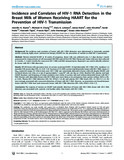Incidence and Correlates of HIV-1 RNA Detection in the Breast Milk of Women Receiving HAART for the Prevention of HIV-1 Transmission
Date
2012Author
Slyker, Jennifer A
Chung, Michael H
Lehman, Dara A
Kiarie, James
Kinuthia, J
Holte, Sarah
Tapia, Kenneth
Njiri, Francis
Overbaugh, Julie
John-Stewart, Grace
Type
ArticleLanguage
enMetadata
Show full item recordAbstract
Background
The incidence and correlates of breast milk HIV-1 RNA detection were determined in intensively sampled women receiving highly active antiretroviral therapy (HAART) for the prevention of mother-to-child HIV-1 transmission.
Methods
Women initiated HAART at 34 weeks of pregnancy. Breast milk was collected every 2–5 days during 1 month postpartum for measurements of cell-associated HIV DNA and cell-free HIV RNA. Plasma and breast milk were also collected at 2 weeks, 1, 3 and 6 months for concurrent HIV-1 RNA and DNA measurements. Regression was used to identify cofactors for breast milk HIV-1 RNA detection.
Results
Of 259 breast milk specimens from 25 women receiving HAART, 34 had detectable HIV-1 RNA (13%, incidence 1.4 episodes/100 person-days 95% CI = 0.97–1.9). Fourteen of 25 (56%) women had detectable breast milk HIV-1 RNA [mean 2.5 log10 copies/ml (range 2.0–3.9)] at least once. HIV-1 DNA was consistently detected in breast milk cells despite HAART, and increased slowly over time, at a rate of approximately 1 copy/106 cells per day (p = 0.02). Baseline CD4, plasma viral load, HAART duration, and frequency of breast problems were similar in women with and without detectable breast milk HIV-1 RNA. Women with detectable breast milk HIV-1 RNA were more likely to be primiparous than women without (36% vs 0%, p = 0.05). Plasma HIV-1 RNA detection (OR = 9.0, 95%CI = 1.8–44) and plasma HIV-1 RNA levels (OR = 12, 95% CI = 2.5–56) were strongly associated with concurrent detection of breast milk HIV-1 RNA. However, no association was found between breast milk HIV-1 DNA level and concurrent breast milk HIV-1 RNA detection (OR = 0.96, 95%CI = 0.54–1.7).
Conclusions
The majority of women on HAART had episodic detection of breast milk HIV-1 RNA. Breast milk HIV-1 RNA detection was associated with systemic viral burden rather than breast milk HIV-1 DNA.
URI
http://erepository.uonbi.ac.ke:8080/xmlui/handle/123456789/21719http://www.ncbi.nlm.nih.gov/pubmed/22253778
Citation
PLoS One. 2012; 7(1): e29777Description
Full text
Collections
- Faculty of Health Sciences (FHS) [10378]

